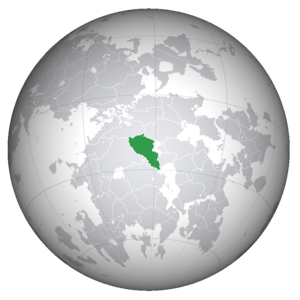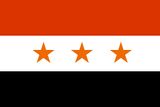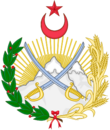Kurzhistan
Kurzhi People's Republic of Kurzhistan | |
|---|---|
| Motto: Allah,Kurzhistan,Duhani | |
 Location of Kurzhistan in Central Thrismari | |
| Capital | Buznar |
| Largest city | Gultan |
| Official languages | Kurzhi |
| Recognised national languages | Kurzhi
Yaddak Abjekh |
| Ethnic groups | Kurzhi 92.45% Yaddak 2.55% Encessi 2.05% Others 2.95% |
| Demonym(s) | Kurzh(s) |
| Government | Unitary one-party Kurzhi socialist republic |
| Fultaz Bin Duhani | |
| Gisnar Al-Fuhad | |
| Legislature | Kurzhi National Assembly |
| Establishment | |
• Foundation of the Republic of Kurzhistan | 1912 |
• October Coup and the Declaration of the Kurzhi People's Republic | 1946 |
| Area | |
• Total | 1,061,070 km2 (409,680 sq mi) |
| Population | |
• 2023 estimate | 38,000,000 |
• 2022 census | 35,556,762 |
| GDP (PPP) | 2021 estimate |
• Total | $266,250,000,000 |
• Per capita | $7,502 |
| GDP (nominal) | 2021 estimate |
• Total | $195,250,000,000 |
• Per capita | $5,506 |
| Gini (2021) | low |
| HDI (2021) | high |
| Currency | Sherih (W) |
| Time zone | UTC-2 |
• Summer (DST) | UTC-2 (not observed) |
| Date format | dd-mm-yyyy |
| Driving side | left |
| Calling code | +91 |
| ISO 3166 code | KHK |
| Internet TLD | .sta |
Kurzhistan, formally known as the Kurzhi People's Republic of Kurzhistan, is a Country located in the region of Central Thrismari inside the continent of Thrismari on Anteria. It is geographically located in the Central Thrismarian highlands, and borders Bashkaristan to its north, Abjekistan to its West and Encessia to its south. Kurzhistan has a population of 35.5 million people as of 2022.
Buznar is the capital and Gulnar is the largest city of the country. Kurzhistan comprises of Twenty six provinces and five districts of importance.
Etymology
Kurzhistan is the common name utilised for the Kurzhi People's Republic of Kurzhistan and has been regarded as the only name that the nation is known as, however that couldnt be further from the truth, Kurzhistan's original termology stems from the yaddak era, when the area was known as Qurzi-sthan or land of the Qurz which was the yaddak abbreviation for the Kurzh People.
As time went on however, the Yaddak's gradually latinised the name, and Qurz became Kurzh while Qurz-sthan came to be known as Kurzhi-stan or Land of the Kurzh, this termiology continued and the region came to be called by its latinized version, i.e Kurzhistan, instead of the generic Qurzsthan, which happened mostly due to the passage of time and the changing linguistics of the abjekh people with names being made easier to memorise and to pronounce, so that administrative works could be easily done.
However, even after kurzhi's won their independence from the yaddaks in the 1910's, this termiology of the yaddaks continued, and the Qurzi's identified themselves as Kurzhi's and their nation as Kurzhi-stan rather than Qurzi-sthan mostly due to the cultural influence of the abjekhs on the kurzhi's as a result of a prolonged administration of kurzhi areas, by the abjekhi royal government that went on for several centuries.
Geography
Physical geography
Climate
History
Prehistoric Era
Modern day Kurzhi's arrived in the area of central thrismari in the 3,000-1,000 BCE period, while this is not clear how they survived in such an environmemt, some documents and remains show that the Early Kurzhi's were mostly hunter gatherers and gathered fruits, nuts and berries from the trees and bushes that they found around them, and hunted small herbivores by using stone tools and bone blades, the later being a speciality of the Kurzhis.
As time moved on the Kurzhi's started to settle down into small communities based inside caves or in the hollow trunks of huge trees, with an average community comprising of about 7-14 members, some communities even united to form larger communities which went as far to comprise of about an estimated one hundred people.
The Kurzhis remained mostly as hunter gatherers from the early 6,000 BCE to about 4,000 BCE, after which they slowly started to advance towards the Age of farming and domestification.
As time advanced the kurzhis slowly began to develop their own set of small farms where they started to farm their first set of vegetables which typically included wheat grains, wild potatoes, etc, in the northern regions of modern day kurzhistan, though due to the highly desertificated structure of that area the kurzhi's couldnt modernize their farming tactics, though they did manage to domesticate their first range of animal life in the early 1000's-500 BCE,
The animals generally included cattles for example, the thrismarian camels and the kurzhi red cow, The Animals were used for mainly plowing and scathing the fields of the kurzhi Tribal land holdings, as well as to develop more advanced methods of seperating the waste products of the wheat from the actual crops.
The farming tactics of prehistoric kurzhi's generally included usage of less water consuming seeds of mostly wheats and wild potatoes, and to use a fairly irrigated field for their cultivation, which mostly refers to the northern temparate lands of kurzhistan and the steppes regions, where two rivers contact, which results in excellent farming regions.
The kurzhi's used mostly stone -tools like stone hoe and stone scathe's for sowing and harvesting the crops, after their maturation period. Though the harvests were usually low, the kurzhi's managed to supplement them with the livestocks they had, for example they used the "camel's meat and milk" harvested and collected from the individual cows and camels, as their main secondary food source during the pre historic times.

